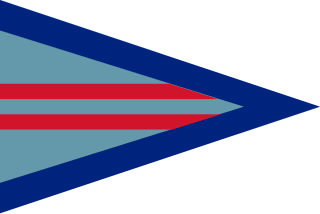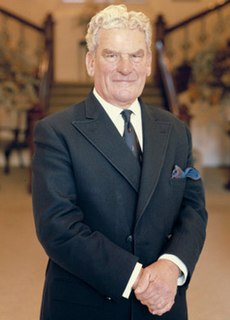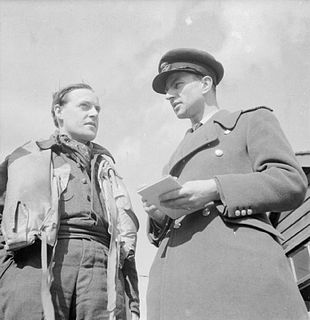Related Research Articles

Marshal of the Royal Air Force William Sholto Douglas, 1st Baron Douglas of Kirtleside, was a senior commander in the Royal Air Force. After serving as a pilot, then a flight commander and finally as a squadron commander during the First World War, he served as a flying instructor during the inter-war years before becoming Director of Staff Duties and then Assistant Chief of the Air Staff at the Air Ministry.

Wing commander is a senior commissioned rank in the British Royal Air Force and air forces of many countries which have historical British influence, including many Commonwealth countries but not including Canada and South Africa. It is sometimes used as the English translation of an equivalent rank in countries which have a non-English air force-specific rank structure. It ranks immediately above squadron leader and immediately below group captain.It has a NATO ranking code of OF-4, and is equivalent to commander in the Royal and US Navies, and to lieutenant colonel in the British Army, the Royal Marines, and the US Army, Air Force, and Marine Corps.

Air Chief Marshal Sir Wallace Hart Kyle, was an Australian who served in the Royal Air Force (RAF) as a senior commander and later as the 24th Governor of Western Australia. Born in Kalgoorlie, Western Australia, Kyle was commissioned into the RAF in 1929, and, having seen service in the Second World War and the Malayan Emergency, held a number of senior positions, including Vice-Chief of the Air Staff and commander-in-chief of the RAF's Bomber Command and Strike Command. He was made Governor of Western Australia in 1975, a position in which he served until 1980, later returning to England, where he died in 1988.

Marshal of the Royal Air Force Sir John Grandy, was a senior officer in the Royal Air Force. He was the only officer who fought and commanded a squadron during the Battle of Britain to reach the post of Chief of the Air Staff. In the latter role he implemented the final stages of the RAF's withdrawal from the Persian Gulf and the Far East, oversaw the ordering and subsequent cancellation of the F-111 strike aircraft and handed over Britain's nuclear deterrent role to the Royal Navy.
The Central Flying School (CFS) is the Royal Air Force's primary institution for the training of military flying instructors. Established in 1912, it is the longest existing flying training school. Its motto is Imprimis Praecepta which is Latin for "Our Teaching is Everlasting". It currently manages a series of training squadrons as well as the RAF Display Team.
Air Marshal Sir Ernest Leslie Gossage, was an officer of the British Army and then of the Royal Air Force. He served as Air Officer Commanding-in-Chief at RAF Balloon Command from 1940 to 1944.
Air Vice-Marshal Ekanayake Edward Rohan Ameresekere DFC & BAR, RCyAF third Commander of the Royal Ceylon Air Force and World War II Royal Air Force Navigator.
Air Commodore Cathcart Michael Wight-Boycott, was a British fighter pilot during the Second World War and a senior Royal Air Force officer during the post-war years. In 1961, Wight-Boycott became the 10th Commandant Royal Observer Corps.
Air Commodore Edward Barnes Sismore DSO, DFC & Two Bars, AFC, AE was a British air navigator and fighter pilot during the Second World War, and a senior Royal Air Force officer in the post-war years. Sismore served as the thirteenth Commandant Royal Observer Corps between 1971 and 1973.
Air Commodore Martin Keith Widdowson was a senior Royal Air Force officer in the 1980s and 1990s and the 24th and last Commandant Royal Observer Corps.

Air Commodore Peter Malam "Pete" Brothers, was a Royal Air Force fighter pilot and flying ace of the Second World War. Brothers was credited with 16 aerial victories, 10 of which he achieved during the Battle of Britain.
Ronald Gustave Kellett, was an English stockbroker who became a flying ace during the Second World War while serving in the Royal Air Force.

No. 615 Squadron was a unit of the British Auxiliary Air Force and later the Royal Auxiliary Air Force between 1937 and 1957.
Joseph Robert Kayll, was a Royal Air Force fighter pilot and flying ace of the Second World War.
Air Vice Marshal Andrew MacGregor, was a First World War flying ace credited with six aerial victories—including three scored with James Grant as his gunner—and a senior commander in the Royal Air Force during the Second World War.

Air Vice Marshal Harold Spencer Kerby, was Canadian-born air officer of the Royal Air Force. He served in the Royal Naval Air Service during the First World War, where he became a flying ace with nine confirmed aerial victories, later transferring to the Royal Air Force, rising to command of British Air Forces in East Africa during the Second World War.

Wing Commander Mark Henry Brown,, nicknamed Hilly, was the first Canadian pilot to become a fighter ace during World War II whilst serving with the Royal Air Force during the Battle of France. He also flew in the Battle of Britain and was killed in action in November 1941 over Sicily.
Air Commodore Roy Gilbert Dutton, was a Royal Air Force officer and decorated flying ace. He flew Hurricanes during the Second World War and was credited with 19 confirmed aerial victories.

Air Commodore Colin Campbell McMullen,, commonly referred to as C.C. McMullen, was an Australian-born Royal Air Force (RAF) officer. McMullen was educated in Sydney, and commissioned as an officer in the RAF after moving to the United Kingdom in 1931. During World War II he commanded two flying squadrons, as well as an air station. He continued to serve after the war and was appointed to command a group shortly before his death in 1954.